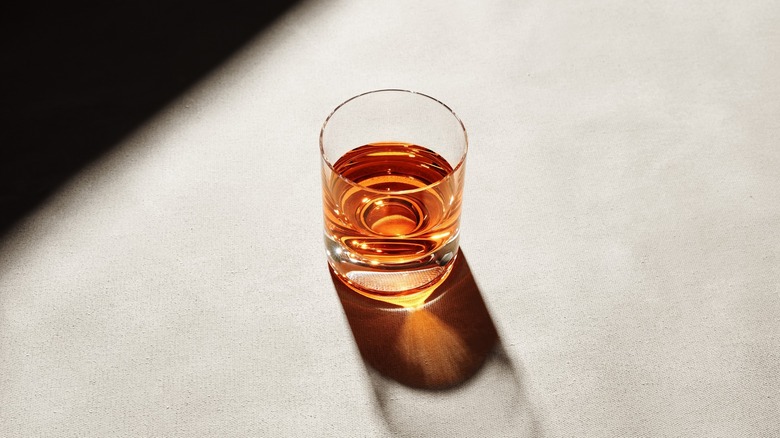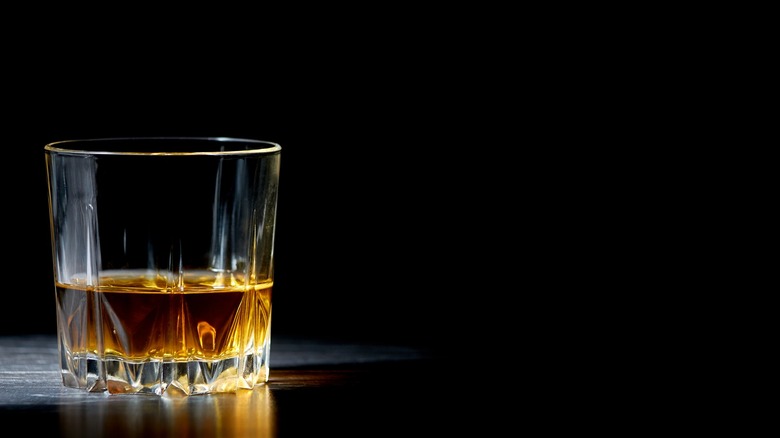What Does It Actually Mean To Take Whiskey Neat?
Ordering drinks at the bar can be intimidating. What's going to infuriate your bartender? How do you tip correctly? Is there a cocktail ordering etiquette in general? Honestly, knowing what you want is a great start, and when it comes to ordering whiskey, the world spans far and wide, and it definitely doesn't stop at just picking out what label, age, and variety. Ordering the way your whiskey is served is also important in determining the kind of drinking experience you'll get. Telling the bartender you want your whiskey "neat" may be a good way of sampling the "purest" essence of a glass, but there are a few caveats you should be familiar with before you commit to this preference.
First of all, whiskey "neat" is different than "straight up" or simply just "up," even though the two terms may sound like they both mean a lack of dilution or additives. Although you may think that there are only two ways of ordering whiskey, either "on the rocks" or just poured directly into a glass without any ice, the terminology gets more specific than this. A serving of whiskey neat is poured from the bottle to the glass without any interruptions so that the drinker can slowly sip and savor the drink. Besides the obvious absence of ice or water, this also means that a bartender technically shouldn't even be using a measurer or any sort of in-between vessel. Neat very specifically refers to pouring the whiskey right from the bottle to the glass. It's that simple.
The difference between neat and up
Maybe you don't want ice melting and slowly diluting your whiskey as you drink it, but maybe you also don't necessarily want to drink room-temperature booze. This is when you would order your whiskey straight up — although simply ordering your glass "up" is probably less confusing for the bartender. Ordering your whiskey up may look the same as neat, but the server will actually run it through an ice bath first before straining it into a glass. Although this will always dilute your whiskey ever so slightly, it's a good way to enjoy the subtleties of a glass while also adding a bit of chill to your drink.
The reason why "up," is the slightly preferred term, by the way, is because "straight up" means different things depending on what you're ordering. The two terms are not interchangeable when ordering cocktails, and even ordering whiskey without dropping the "straight" part may get you the wrong order. Bartenders can sometimes interpret "straight" as whiskey without any additives, making it the same as "neat." To make matters even more perplexing, the term "straight whiskey" actually refers to the amount of time a batch has aged, not technically a serving method.
When should you order a whiskey neat?
Not all whiskeys are necessarily best enjoyed neat, just like not all whiskeys should be served on the rocks. Of course, some whiskey sommeliers may disagree and believe that all whiskey should ideally be served without any impurities ruining the delicate taste, but the pro-rocks school is larger than you probably think it is. In fact, some connoisseurs swear that adding just a few drops of water actually helps to bring out more flavor notes instead of burying them. The truth is that there really is no truth, and the debate over the right way to serve a glass of whiskey will rage on forever (or, considering how mellow drinking whiskey can be, continue in a civilized manner forever, perhaps with a few cigars).
If you want to start off by trying out whiskey neat, it may be wise to stick with the sweeter options, at least at the beginning of your whiskey-tasting journey. Test a bourbon out — or, if you're feeling a little more adventurous, travel down the spicier route and go with a rye. Curious about the varieties? Chat with your bartender when the bar is slow for some expertise. If none of these suit your palette, you can always add ice or water afterward.



